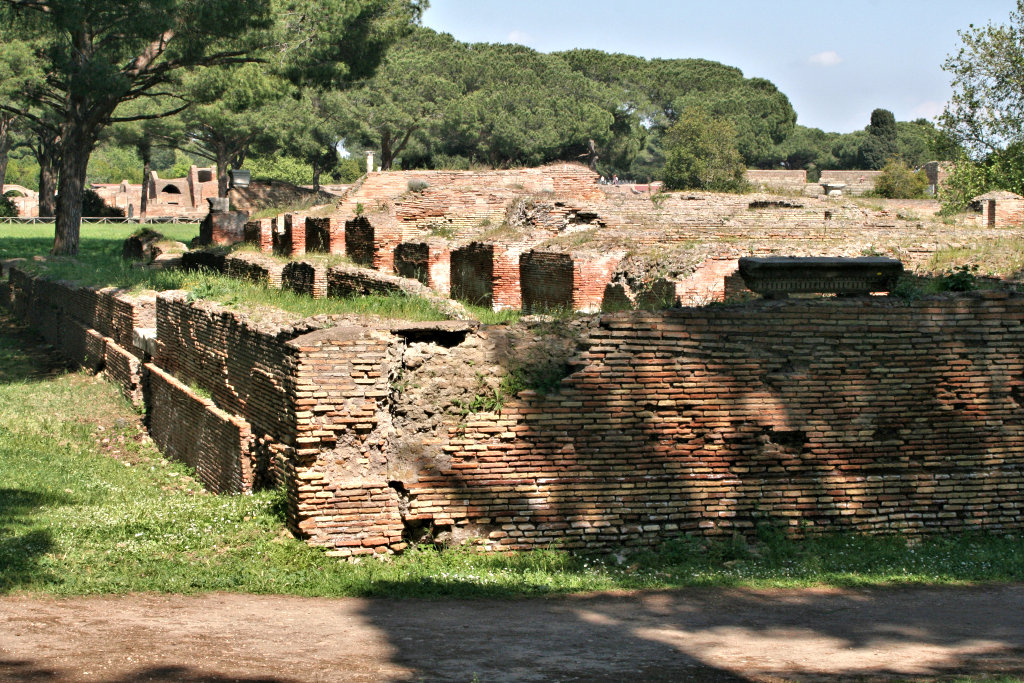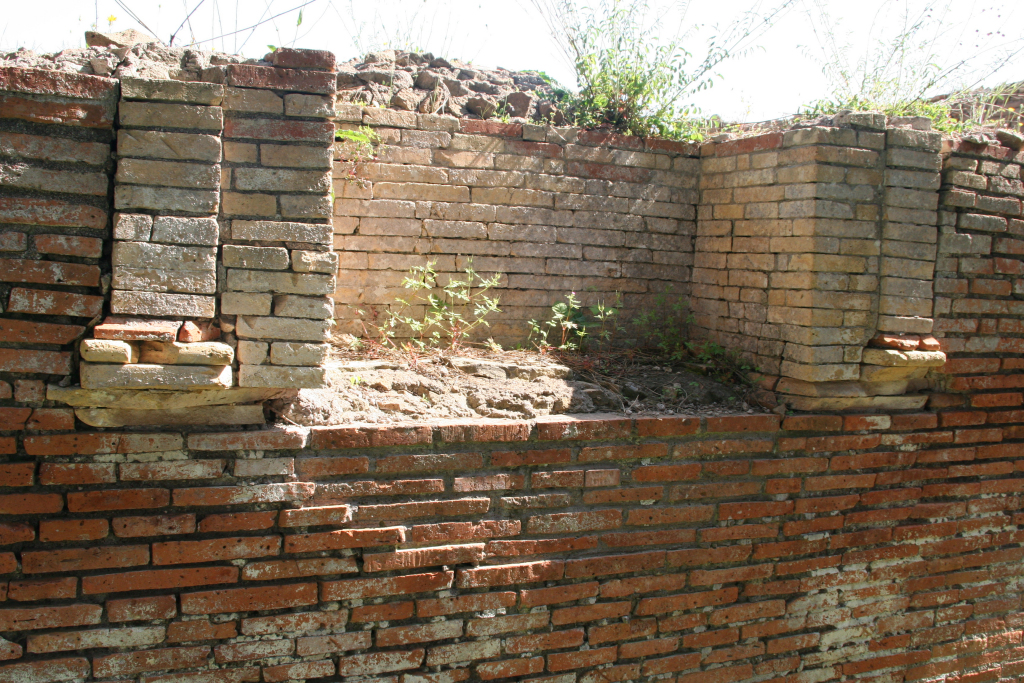The poor state of preservation of the Great Warehouse is in sharp contrast with its importance. Many of the large tufa blocks from the outer west and east wall were reused in the Casone del Sale - the present museum -, built in the second half of the 16th century. Two lime-kilns were found in the building. The east facade was unearthed by Rodolfo Lanciani in 1885-1886, most of the building was excavated by Guido Calza at the end of the First World War.
Work on the Grandi Horrea was begun during the reign of Claudius. The building was accessed from the north, that is from the Tiber quays. At the north end was a porticus of tufa columns, resting on travertine bases. The west and east wall were made of large tufa blocks (h. 0.53-0.66, w. 0.59) with an intentionally rough surface, the opus rusticum that is characteristic of the reign of Claudius. This sturdy building technique was chosen either to give the building an impressive appearance, or to safeguard it from fires. The back (south) wall was made of latericium. All inner rooms (cellae) were rebuilt later. They were arranged around a U-shaped courtyard, surrounded by tufa columns with Doric, travertine capitals. The floors were made of waterproof opus signinum. The original building had no staircases and no upper floors.
During the reign of Nero or shortly afterwards long rows of rooms were added to the east and south. The outer wall of the rooms facing the east was also made of large tufa blocks, but these had a smooth surface. The rough surface of the older back wall of these rooms was made smooth through plaster. The walls between the rooms were built in latericium. The rooms had a mezzanine floor. In the centre of the row is a staircase. In front of the row was a porticus of travertine columns.
The walls of the south row are in latericium. These rooms too had mezzanine floors, and the porticus in front of the east rooms continued in front of the south rooms. Between the south rooms are staircases with travertine treads. The travertine thresholds of these rooms are rather enigmatic. It seems that, originally, they were smooth, suggesting that the rooms had no doors. At some point in time a depression for a door was hacked out in the centre. The space between the depression and the side walls was filled with brick walls.
First phase: Claudius.
Rickman 1971, fig. 11.Second phase: Commodus.
Rickman 1971, fig. 12.Final phase: Severan and later.
Click on the image to enlarge.
Parco Archeologico di Ostia.During the reign of Commodus (brick stamps from the reigns of Marcus Aurelius and Commodus were found) many rooms were rebuilt in latericium. Suspensurae (raised floors) were added, to protect the goods that were stored from vermin and moisture. At least one floor was added, witness four staircases, with travertine steps, in the corners of the interior.
The north part of the building was raised and rebuilt, with suspensurae, under Septimius Severus and in the later Severan period. From now on the building had only one, narrow entrance, in the centre of the north wall. The two northern staircases were replaced by staircases of eight treads followed by a sloping ramp, in order to facilitate the carrying of goods by porters. In the north-east part a cult niche was installed.
Supporting bricks piers and arches were set against the outer south wall. On Via dei Molini - the road to the west - five arches, spanning the road, were added. Between these arches two small rooms were set against the west wall of the building. In these rooms the lower part of two staircases was found: two treads and a landing, the latter to support a ladder. The ladders cannot have been used for transporting goods, ladders are of course not suited for porters carrying loads. Because there are two ladders, many people were expected to use them. Possibly this was a fire escape: after the rebuilding in the Severan period the building had only one, narrow exit.
Various other modifications cannot be dated accurately:
- the installation of a large water-basin in the south-east part of the U-shaped courtyard
- the blocking of the colonnades in the interior, and in front of the east and south rooms (opus latericium and reticulatum)
- the erection of brick piers in the south-east part of the courtyard
- the destruction of the rooms inside the U-shaped courtyard
- the installation of floors of basalt blocks in some of the east rooms, and in the porticus in front of these rooms.A group of coins found below a collapsed wall in the north part indicates that the building was no longer in use at the end of the fourth century.
This very large depot has always attracted much attention. Citing Rickman: "Its size, complexity and solidity, and not least its position, all indicate that the Grandi Horrea was a publicly owned storehouse, and the presence of suspensurae, at least from the middle of the second century, would indicate that perishable foodstuff, probably grain, was stored in it". According to Hermansen the ground floor of the original building alone could hold 5.660 to 6.960 metric tons of grain. If we assume that one person needed five measures (modii) of grain per month, then the building would have contained grain for one year for 14.000 to 17.300 persons. After the addition of an extra floor the number must have been much larger (but if the building contained reserves for one year, the number must be halved).








